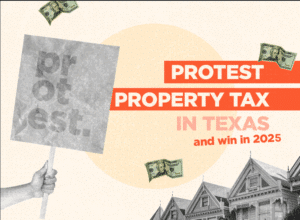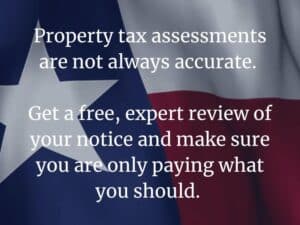If you own commercial property in Texas, and that appraisal notice caught you off guard this year, you’re not the only one. Many business owners are now considering a commercial property tax protest as a way to address these surprising assessments. Business owners across the state are opening envelopes that feel more like bills than fair assessments. Some are facing values that jumped overnight. Others are trying to make sense of a number that doesn’t reflect the actual condition or income of the property.
This guide is for you. It’s written for commercial property owners who don’t have a legal team or a tax department handling things behind the scenes. Whether you manage office space, lease out a warehouse, or own a few retail units, this post will help you understand how the protest process works, what makes commercial protests unique, and how to protect yourself from paying more than you should.
You’ve already got enough to deal with. Let’s make sure your property taxes aren’t working against you.
What Makes a Commercial Protest Different from a Residential One
The appraisal protest process might follow the same timeline for everyone, but the details shift when you’re dealing with commercial property. Homeowners usually protest based on comparable sales. The process is often focused on square footage, condition, and neighborhood value. With commercial properties, it’s not that simple.
Counties look at income potential, lease terms, vacancy rates, operating expenses, and more. They might apply a blanket cap rate to an entire class of buildings, regardless of what your actual numbers show. This means your valuation could be based on assumptions that don’t match your reality.
A single misstep in how the county calculates your property’s income can inflate your value by hundreds of thousands of dollars. And unless you correct it, that becomes your tax base for the year.
Commercial properties also require more documentation. Rent rolls, income statements, and maintenance records aren’t just helpful. They’re often expected.
Bottom line: commercial protests are more technical, more document-heavy, and more reliant on financial accuracy. That doesn’t make them harder. It just means they require a different approach.
Why Commercial Property Values Are Often Too High
It’s not unusual for commercial property owners to feel blindsided by their appraised value. And more often than not, there’s a reason for it. Counties rarely arrive at these numbers by accident. They rely on formulas, assumptions, and limited data, and those assumptions don’t always reflect your reality.
A common issue is how income is estimated. Many appraisal districts assume your building is fully leased at market-high rates. If you’ve had vacancies, month-to-month tenants, or lowered rents to retain occupancy, that likely isn’t showing up in the math.
Expenses can also be misunderstood or ignored. Things like insurance, property taxes, maintenance costs, and management fees all reduce net income, but they’re not always applied accurately in the county’s model.
In some cases, properties are grouped into broad categories. A professional office building with aging infrastructure might be evaluated the same way as a newly renovated one with premium tenants. When models prioritize generalizations over details, the numbers start to drift.
And then there’s human error. Incorrect lease data, outdated records, or skipped depreciation adjustments can all push a valuation higher than it should be. That’s why every notice deserves a second look, even if the increase seems small.
How Appraisal Districts Calculate Commercial Property Value
When it comes to valuing commercial property, appraisal districts usually rely on one of three methods. Sometimes they use a combination. Each method has its place, but the choice they make can impact your bottom line.
The most common for commercial buildings is the income approach. This method estimates how much revenue the property can generate, then subtracts expenses to arrive at a net income. That number is divided by a capitalization rate to determine the final value. If the income is overstated or the cap rate is too low, your appraised value can shoot up fast.
The second is the sales comparison approach, which looks at recent sales of similar commercial properties. This can work well in active markets, but it’s not always accurate. Sales data can be limited, and no two buildings are truly alike when it comes to use, condition, or lease structures.
The third is the cost approach, used more often for special-use buildings or new construction. It estimates how much it would cost to rebuild the property from scratch, then subtracts for age and wear. This method can be helpful for properties with limited income data, but it often fails to reflect current market value.
Knowing which method was used and whether it fits your specific property is the first step in deciding if a protest is worth filing.
What Evidence Helps in a Commercial Property Tax Protest
If you’re planning to protest your commercial valuation, documentation matters. The appraisal district may have made assumptions about your property. Your job is to show them what’s actually true.
Start with your rent roll. This shows who is leasing space, how much they’re paying, and whether the property is fully occupied. If you’ve had vacancies, short-term tenants, or reduced rents, your rent roll tells that story clearly.
Next, gather your profit and loss statements. These help the county understand your net operating income. Property taxes, insurance, maintenance, and management fees all reduce your bottom line, and they need to be part of the conversation.
If you’ve had a third-party appraisal done recently for financing or refinancing, it may support your protest. This is only helpful if the appraisal reflects current market conditions and is lower than the county’s number.
You should also consider photos or repair estimates, especially if the property has deferred maintenance. Appraisers may overlook worn roofs, foundation issues, or aging systems when they’re relying on paperwork alone.
And if you’ve had vacancy issues, bring proof. Utility records, lease terminations, or broker listings can all show that certain spaces were not generating income during the year in question.
The goal is to present a complete, honest picture of your property’s actual value in the current market. That’s what a protest should correct.
What to Expect from Informal and Formal Hearings
The protest process usually begins with an informal meeting at the appraisal district. This is your first opportunity to present your evidence, explain the story behind the numbers, and ask for a correction. Sometimes, that’s all it takes. If the appraiser agrees with your documentation, they may offer to lower the value on the spot.
If you don’t reach an agreement, the next step is a formal hearing with the Appraisal Review Board. This is a panel of local citizens who are trained to review property protests. You’ll present your case in a short, structured session. The county will present theirs, and the board will make a decision based on what’s shown.
For commercial property owners, these hearings can feel intimidating at first, but they’re meant to be accessible. You don’t need to be a lawyer or a tax professional to attend. You just need to be organized and prepared.
Some counties allow additional steps after the ARB, such as arbitration or district court appeals. Most owners don’t go that far, but it’s important to know your rights if the outcome doesn’t reflect the evidence.
Whether it ends at the informal meeting or goes all the way to a formal hearing, the goal is the same. You’re there to correct the record, not to create conflict. And when you come prepared, your chances of success improve significantly.
Common Mistakes Commercial Property Owners Make
Most commercial property owners aren’t trying to cut corners. They’re busy running businesses, managing tenants, or overseeing buildings that take real time and effort. But when it comes to property tax protests, even small oversights can cost you.
One of the most common mistakes is filing without the right evidence. If you submit a protest but don’t provide supporting documentation, the county has no reason to reconsider their original number.
Another issue is using residential comps or relying on sales data that doesn’t match your property type. A retail strip center doesn’t function like an apartment complex, and neither should it be compared to a warehouse. The county expects you to compare apples to apples.
Deadlines are another common stumbling block. Once your notice is sent, you have a limited window to respond. Missing that deadline means you’re stuck with the county’s value for the rest of the year, no matter how inaccurate it may be.
Some owners also rely too heavily on property managers or accountants to handle the protest process. These professionals are valuable, but unless they specialize in property tax matters, they may not know what evidence to submit or how to present it effectively.
The bottom line is this: Protesting a commercial appraisal takes accuracy, timeliness, and the right information, but the process itself isn’t complicated. A few small steps now can prevent a much larger tax bill later.
How Multi-Tenant and Special-Use Properties Are Treated
If you own a multi-tenant building, a mixed-use space, or a property with a specific purpose like a church, clinic, or event venue, your protest may require extra attention. These types of properties often don’t fit neatly into the appraisal district’s standard categories.
With multi-tenant properties, the county might assume that every unit is leased, that rents are consistent, and that your turnover is low. But you know better. Maybe a key tenant moved out, or maybe half your units are on short-term leases. If the appraisal doesn’t reflect that reality, the value could be inflated.
For example, mixed-use properties a retail space on the bottom floor and apartments above can be even trickier. Each portion of the building may generate different types of income, with different risks and operating costs. If the appraisal district treats the entire property as one use type, you could end up overvalued.
For special-use properties, the county might default to the cost approach, which doesn’t always consider things like limited resale potential, zoning restrictions, or operational challenges. That’s why it’s important to provide evidence that shows not just what the property is, but how it actually performs.
These situations are common, and they’re not a reason to panic. They just require a more thoughtful strategy. The more clearly you can present your unique circumstances, the more likely the county is to correct their assumptions.
When to Hire a Professional and When You Might Not Need To
Some commercial property owners are comfortable handling a protest on their own. If you’ve done this before, you know how to prepare your financials, and you have time to meet deadlines, you may not need help. For certain properties, especially those with stable income and simple lease structures, filing directly with the county can work just fine.
But many owners find the process more complicated than expected. Maybe your rent roll has changed three times this year, maybe your expenses don’t line up neatly, or maybe you’re not even sure how the county arrived at your value in the first place.
That’s where a professional can make the difference. Protesting isn’t just about submitting paperwork. It’s about knowing how the county thinks, what kind of evidence carries weight, and how to correct the record without overcomplicating your case.
At Texas PVP, we take time to evaluate each property before deciding to move forward. If we don’t think a protest will help, we’ll tell you. But if there’s a case to be made, we’ll handle it with the same level of care and strategy we’d expect if it were our own property on the line.
Hiring a firm isn’t always necessary. But when the stakes are high or the situation is unclear, it can give you peace of mind, and sometimes, a much lower tax bill.
Deadlines and Documentation Tips Every Commercial Owner Should Know
Timing matters. Once your appraisal notice is delivered, the countdown begins. In most counties across Texas, you have 30 days from the date the notice is mailed to file your protest. That deadline typically falls on May 15, but it can vary slightly depending on when your specific notice was sent. Missing it means you’re locked into that value for the year, regardless of how unfair it might be.
If you’re even considering a protest, start gathering your documentation now. Your rent roll, profit and loss statement, and any recent lease changes are a great place to begin. Add in photographs, repair estimates, or any other details that show the real condition or performance of your property.
If you’re still waiting on final financials, don’t let that delay your filing. You can submit your protest and supplement the evidence later, as long as you meet the initial deadline. Many owners assume they need everything perfect before they start, but waiting too long can cost you the chance to protest at all.
The protest process may not be something you look forward to, but it’s a chance to set the record straight. And when the paperwork is handled properly, it can bring real savings without the stress of scrambling at the last minute.
Final Thoughts: Fairness Isn’t Too Much to Ask
You didn’t ask for an inflated appraisal. You didn’t ask to spend your time sorting through tax rules and financial paperwork. All you’re asking for is accuracy, and that’s a reasonable thing to expect.
Owning commercial property in Texas already comes with enough challenges. Your tax bill should reflect the actual condition and performance of your property, not a formula built on incomplete assumptions. When you review your notice, you’re not trying to avoid taxes. You’re making sure you’re being taxed fairly.
At Texas Property Value Protest, we’ve helped thousands of property owners work through this process with confidence. Whether you manage one building or many, we take the time to understand your specific situation and give you real answers. If a protest can help, we’ll show you how. If not, we’ll be honest about that too.
A proper protest isn’t just about saving money. It’s about correcting the record, protecting your budget, and knowing that someone is advocating for your side. If you’re unsure where your value stands, we’re here to take a look. No pressure. Just clarity and experience from people who know the system and believe it should work for you.






